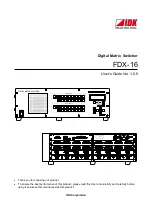
Introduction
1.5 Supported Fiber Optic Cables
Recycling and Disposal
For environmentally friendly recycling and disposal of this device and related
accessories, contact a facility certified to dispose of waste electrical and electronic
equipment. Recycling and disposal must be done in accordance with local
regulations.
1.5
Supported Fiber Optic Cables
The following fiber optic cable types are supported under the stated conditions.
Distance (m)
Cable Type
Wavelength (nm) Modal Bandwidth
(MHz·km)
100Base-FX
1000Base-SX
10GBase-SR
850
200
—
275
33
OM1 (62.5/125)
1300
500
2000
—
—
850
500
—
550
82
OM2 (50/125)
1300
500
2000
—
—
850
1500
—
550
300
1300
500
2000
—
—
850
3500
—
550
400
1300
500
2000
—
—
Laser optimized.
1.6
Using Straight Through or Crossover Copper Wiring
To accommodate signals from end devices and network switching equipment, the
RUGGEDCOM RMC is equipped with an
X-Over
switch. This switch allows for the
proper connection regardless of the cable type configuration.
CAT-5 network cabling can be constructed in two possible configurations: Straight
through and crossover (X-over). Straight through cabling involves a pin-to-pin
connection, while crossover cabling matches the transmitting differential pair to the
receiving differential pair. The following summarizes the two possible configurations:
TIA 568B Straight Through Pinout
Device 1
Device 2
Pin
Colour
Pin
Colour
1
White/Orange
1
White/Orange
2
Orange
2
Orange
3
White/Green
3
White/Green
6
Green
6
Green
TIA 568B Crossover Wiring Pinout
Device 1
Device 2
Pin
Colour
Pin
Colour
1
White/Orange
1
White/Green
2
Orange
2
Green
3
White/Green
3
White/Orange
6
Green
6
Orange
When connecting to end devices, the
X-Over
switch should be selected to reflect the
type of cabling used. Specifically, straight through should be selected when using
straight through cabling, and crossover should be selected when using crossover
cabling.
4
RUGGEDCOM RMC
Installation Manual, 04/2021, C79000-G8976-1006-10














































